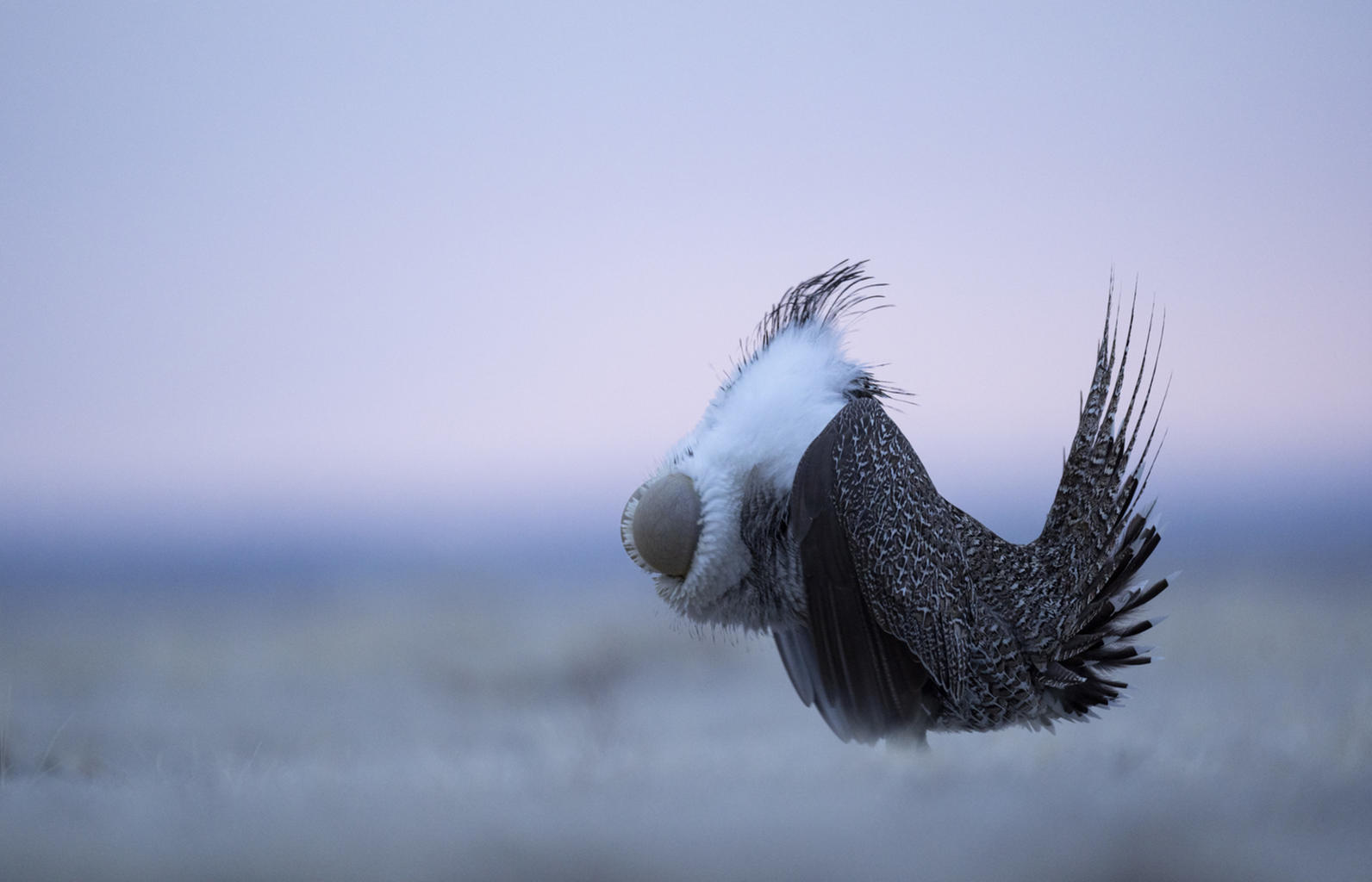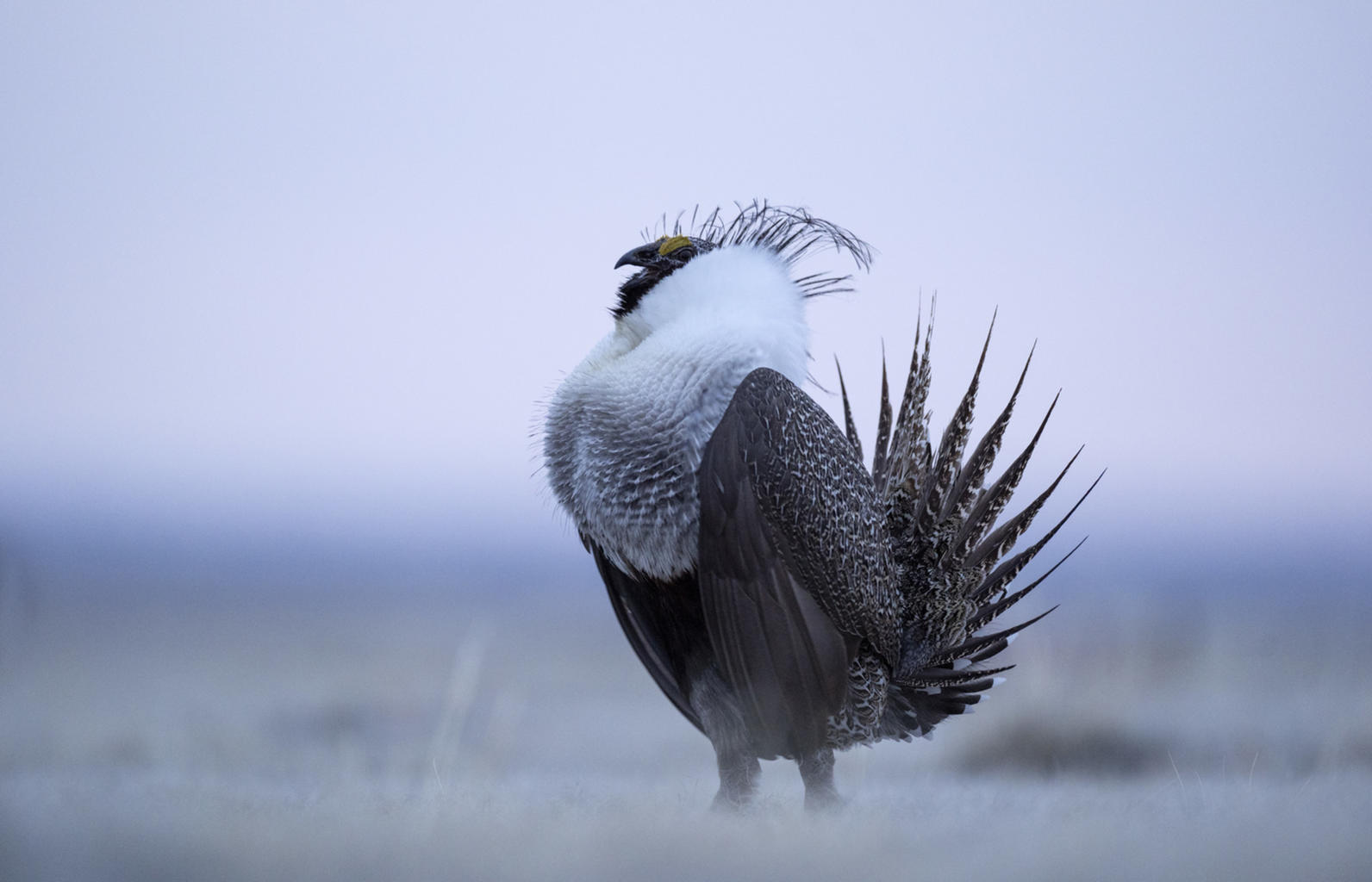Spring is setting in across the Great Basin, land that includes remote corners of California in the eastern shadow of the Sierra Nevada, as well as almost all of the state of Nevada. The season heralds one of the most spectacular rites of spring in the western U.S.: the annual mating dance of the Greater Sage-Grouse.
This year, the U.S. Fish and Wildlife Service chose to mark the occasion by deciding not to list as threatened a subspecies of the chicken-sized chicken relative, the Bi-State Greater Sage-Grouse, found only in California and Nevada.
As I read the news, I could not help but remember how I’ve been lucky enough to witness the Greater Sage-Grouse’s dramatic lekking behavior set before the backdrop of snow-capped Eastern Sierra mountains. Bundled into many layers in freezing temperatures a few years ago, I arrived at a lekking site just before sunrise as more than 50 males started their booming and strutting.
In a comical display that is hard not to anthropomorphize, the males ran into each other, breasts inflated and tail feathers fanned. Females wandered around, seemingly oblivious and unimpressed. As the morning light brightened, the birds dispersed into the surrounding landscape, blending into the sagebrush until they would return the next morning to repeat their ritual.



The Bi-State Greater Sage-Grouse is an isolated and distinct population along the California-Nevada border, meaning it is disconnected from the Greater Sage-Grouse populations across the West. The bird’s range includes the majority of Mono County, the White Mountains in Inyo County, and portions of several counties in western Nevada. For decades, researchers have charted the Bi-State population’s decline, reporting that the current range of the population, along the California and Nevada border, comprises less than half of its historical range.
The timing of the U.S. Fish and Wildlife Service (USFWS) decision in late March not to list the Bi-State population of Greater Sage-Grouse as threatened under the Endangered Species Act (ESA) comes just as the grouse gather in California’s Eastern Sierra to initiate their fascinating mating rituals.
The Service’s decision is a milestone in the multi-year effort by environmental groups and agencies to protect and conserve this special and rare bird. It is also an indicator to those of us who care about these birds, that there is a lot of work ahead of us to preserve this species and its important place in California’s natural history.
In response to this decline, the USFWS proposed listing the bi-state population as threatened under the ESA in 2013. In 2015, the Service reversed course, stating that the population did not warrant listing, based on the development of the Bi-State Action Plan and significant federal funding allocated to conservation projects.
In 2016, Center for Biological Diversity and other conservation groups filed suit to challenge the decision. In 2018, the courts ruled to dismiss the Services decision to withdraw proposed listing and ordered the Service to reconsider listing. In 2019, the U.S. Geological Service (USGS) released a report showing a population increase between 1994 and 2018, which is great news and can be at least partially attributed to the collaborative work of agencies and landowners.
However, USGS also found that the species’ overall range had contracted and many of the smaller groups along the edge of their range have declined substantially, possibly in part due to drought or disturbance pressures. Despite these concerns, the Service determined in late March 2020 that listing was not warranted because “the threats to the DPS (Bi-State Population) as identified in the proposed listing rule no longer are as significant as believed”.
Audubon California, along with Eastern Sierra Audubon Society, supported the Service’s initial proposal to list the population as threatened under the ESA. While we are disappointed with the Service’s decision this week, we commend the Service, the Natural Resource Conservation Service, Bureau of Land Management and many other stakeholders for creatively collaborating to protect the Bi-state Greater Sage Grouse. The Bi-State Working Group has made important strides in protection populations and restoring habitat.
The Service’s decision only means that even more extraordinary and innovative efforts will be required to conserve this rare population. In 2018, USGS estimated the population at only 3,300 birds and noted that many of the subpopulations were in precipitous decline and in danger of extirpation, which could cascade into an overall decline for the bi-state population.
Moreover, impacts from climate change – including drought – are a significant threat to the population’s viability and will likely worsen in coming years.
For the moment, the Service has put its trust in the collaborative conservation measures. However, if these efforts continue to be insufficient to stabilize and recover the species, the question of listing will have to be revisited and stronger incentives and regulation will be necessary to keep the bi-state population from being extirpated.
As I sit cloistered in my home office in this difficult time, I have to smile at the thought of being in those wide-open spaces, surrounded by colleagues, friends, and other birders, watching these amazing birds just go about their business of survival. It provides me with even more motivation to get through our current crisis safely and healthily, ready to get back out to see these marvelous birds and the places where they live.




